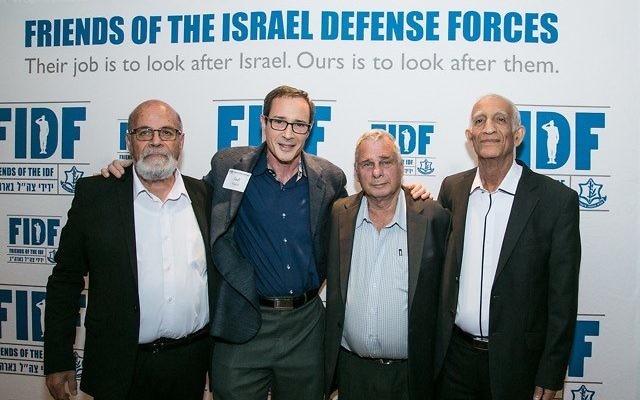Wisdom From the Wall: Put Down the Wine
The three paratroopers made famous by a Six-Day War photo are well aware of their place in history.

I didn’t expect to be told by an Israeli guy I’d never met that I had to put down my wine glass for a photo with him, even if he was an Israeli.
But this was no ordinary Israeli.
Zigi is one-third of the trio — Zion “Zigi” Karasanti, Haim Oshri and Yitzhak Yifat — photographed by David Rubinger in what was to become the visual symbol of the Six-Day War. The three men were the reason we came together for the Friends of the Israel Defense Forces event at The Temple on June 12: It was about nothing less than the reclaiming of the location of the Holy Temple in Jerusalem.
When I walked over to have my photo taken with them, the cheese plate was parked, but the glass of wine was still in hand. Maybe it was the kippah on my head that prompted Zigi to say to me in Hebrew, “Put down your wine; this is a historic moment.”
I thought this was a little odd. I didn’t think it was disrespectful to have a glass of wine in my hand for my photo; I thought it suggested a toast. But saying yes to this request was easy enough, so I did.
This moment — a photo opportunity for me, just one guy at the event 50 years later — also didn’t quite seem historic. But commemorating this moment was just as distinctive for Zigi as it had been 50 years ago.
The event at The Temple had even the most jaded among us on the edge of our seats, hanging on every word, as this remarkable trio of paratroopers told the personal stories of their experiences — fighting their way through the narrow alleys of Jerusalem and taking back a sliver of land that represents our direct connection to Jewish history.
As the event concluded, I was still eager to understand their personal perspective on being part of an iconic image.

In the most famous photo of the Six-Day War, Israeli paratroopers (from left) Zion Karasenti, Yitzhak Yifat and Haim Oshri stand in front of the Western Wall shortly after its liberation June 7, 1967.
I had to lasso Zigi to ask my question. He wanted to speak only in Hebrew. So I struggled through articulating my question in English in my own mind, then translating it into something resembling conversational Hebrew.
I wanted to know what he felt being part of an iconic photo. Did he think of himself as just another soldier? Was that photo a big deal or not such a big deal?
From my perspective, I thought so many Israelis have a jaded, no-big-deal attitude about lots of things. In 1967, or 50 years later, did he take it in stride, or did he think of it as momentous?
Over the din of the crowd, with measured clarity and pride, he told me how he felt about that snap of the shutter.
“The moment that you are fighting for in Jerusalem, and you arrive at the moment that they make you a hero, so then you can speak to the people, to the Jews, to the world, because they know that you participated in the war, and, therefore, you succeeded in being in the picture. And you arrive with that picture where everyone recognizes you,” Zigi said.
“And after all, every war has a semel.”
Every war that is fought has a semel? I didn’t understand that word, semel, so I asked its meaning.
“I will tell you in a minute,” Zigi said. But as he went on, I was stuck understanding the meaning, so I asked again “Mah-zeh ‘semel’?”
“The semel of that war is us, the three paratroopers,” he said.
“When people see the picture, they say, ‘They are the ones who fought in the Six-Day War.’ When one sees the picture of the soldier in Iran, he says, ‘This is the war.’ … For everything there has to be a semel.”
“What’s a semel?” I asked this other gentleman. He explained that it is “a symbol. There’s no war without a symbol. He’s saying that they were blessed to be the symbol. They can go out … and tell the story.”
“I want you to explain that we are the semel of war,” Zigi said. “There is no war that doesn’t have a semel. You understand? So the moment we received the (recognition of becoming the) semel of war, we could come to the public and tell the story of the war.”
I struggled to ask whether during his life it changed everything.
“Certainly!” he said. “It changed my whole life. It’s a change of a person’s entire life. We’re connected to history, you know. … We’re connected to history.”
That night on Peachtree Street, Zigi connected us all. We got the picture of a moment that is history, connecting us viscerally to our rich heritage. And to that, I lift my glass of wine.
Big thanks to Rina Chaya (Siegelman) Lebovic for the Hebrew translation of Zigi’s remarks. Joel Alpert is a former newspaper reporter and editor for secular and Jewish newspapers in New York and now a branding and marketing guy in Atlanta.



comments